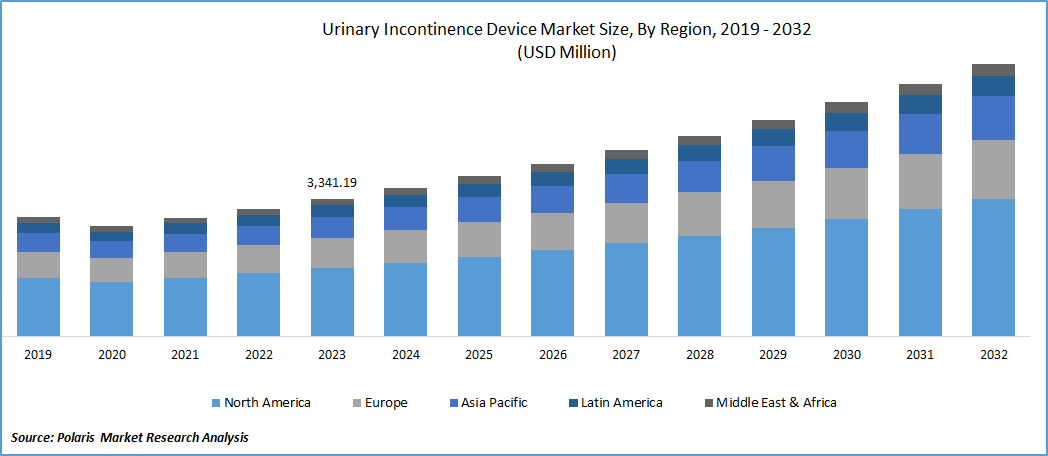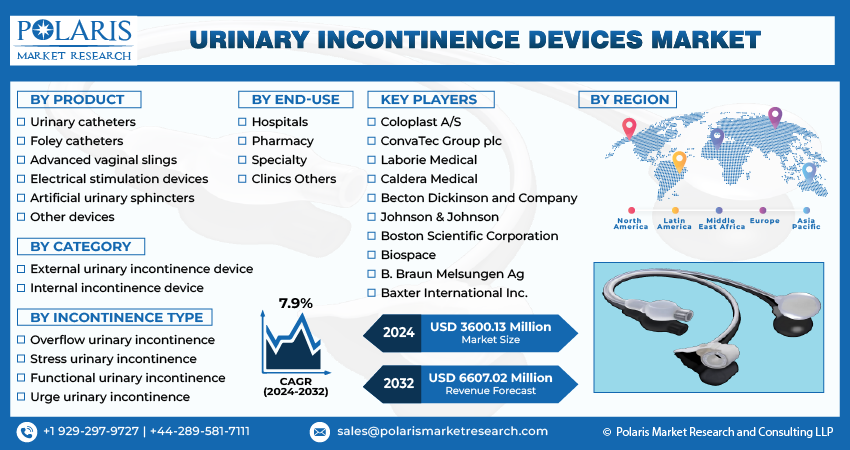
Urinary Incontinence Device Market Share, Size, Trends, Industry Analysis Report, By Product (Urinary Catheters, Foley Catheters, Advanced Vaginal Slings, Electrical Stimulation Devices, Artificial Urinary Sphincters, Other Devices); By Category; By Incontinence Type; By End-Use; By Region; Segment Forecast, 2024- 2032
- Published Date:Mar-2024
- Pages: 116
- Format: PDF
- Report ID: PM4405
- Base Year: 2022
- Historical Data: 2019-2022
Report Outlook
Urinary incontinence device market size was valued at USD 3,341.19 million in 2023. The market is anticipated to grow from USD 3,600.13 million in 2024 to USD 6,607.02 million by 2032, exhibiting the CAGR of 7.9% during the forecast period.
A urinary incontinence device is a product or medical device designed to manage or address urinary incontinence, which is the unintentional loss of urine. These devices are created to provide support, protection, or assistance in controlling bladder function. There are various types of urinary incontinence devices available, and they cater to different needs and preferences.
The urinary incontinence device market experiences growth driven by an increased prevalence of urological disorders and the development of advanced devices for managing urinary incontinence. Additionally, the market is propelled by a growing demand for minimally invasive procedures, particularly among the aging population, which is more susceptible to urological issues.

To Understand More About this Research:Request a Free Sample Report
The shift of urinary incontinent patients from traditional methods is expected to rise in the foreseeable future, further contributing to market expansion. Despite these positive factors, the need for more awareness about recent advancements in urinary incontinence devices and challenges associated with post-operative care pose constraints on market growth. Nevertheless, the market is anticipated to find new growth opportunities due to an increase in healthcare spending in developing nations.
Furthermore, the rising geriatric population across the globe and increasing awareness regarding the device use of urinary incontinence devices are increasing, and we are expected to see tremendous growth during the forecast period. Technological advancement and rising healthcare expenditure among individuals result in an increase in urinary incontinence device market opportunity.
The global outbreak of COVID-19 has caused significant disruptions in healthcare workflows worldwide, due to temporary closures across various healthcare sub-domains. The urinary incontinence industry, in particular, has experienced an overall negative impact due to the pandemic. Throughout the year 2020, the healthcare sector witnessed a notable decline in various outpatient tests and treatments. Surgical procedures related to female urinary incontinence, infertility, kidney stones, and bladder stones were particularly affected, experiencing substantial reductions in service rates during the COVID-19 pandemic.
The prevalence of urinary incontinence tends to increase with age. As the global population ages, there is a growing demographic of seniors who may require urinary incontinence devices. Greater awareness about urinary incontinence and available management options can lead to more individuals seeking solutions to contribute the growth of the urinary incontinence device opportunity.

Key Takeaways
- North America dominated the largest market and contributed to more than 35% of share in 2023
- The Asia Pacific region anticipated to grow at fastest CAGR during the forecast period.
- By product category, urinary catheters segment held the largest revenue share in 2023
- By end-use category, the hospital segment is projected to grow at fastest CAGR during the projected period
What are the market drivers driving the demand for thin film solar cell market?
- Increasing Prevalence of Chronic Diseases
The increasing prevalence of chronic diseases such as heart disorders due to paralysis, brain stroke, kidney failure, and other diseases across the globe will facilitate market growth. Ongoing innovations in the design and technology of urinary incontinence devices can lead to more effective and comfortable products. This attracts consumers and contributes to market growth.
Increased healthcare spending, both by individuals and governments, can support the growth of the urinary incontinence device market. This financial support can lead to better accessibility to these products. The expansion of healthcare infrastructure, especially in developing regions, can open up new markets for urinary incontinence devices. Improved access to healthcare facilities drives urinary incontinence device market growth.
Which factor is restraining the demand for thin film solar cells?
- Lack of Awareness
The need for more awareness about urinary incontinence devices, both among patients and healthcare providers, may hinder market growth, due to underdiagnosis and underutilization of available products. This lack of awareness may result in delayed diagnosis and treatment initiation, causing prolonged discomfort and reduced quality of life for affected individuals who need to be made aware of effective solutions.
Moreover, the limited awareness affects patient education efforts, with healthcare providers potentially needing to educate their patients about available urinary incontinence devices, their benefits, and proper usage. This lack of education contributes to underutilization and a lack of confidence among patients in adopting these solutions.
Furthermore, the cost of urinary incontinence devices may act as a restraining factor, particularly for certain population segments. Limited reimbursement coverage for these devices can pose financial challenges for both patients and healthcare providers, creating additional obstacles to their widespread adoption. Collectively, addressing these issues requires comprehensive awareness campaigns, educational initiatives, and measures to reduce stigma. Additionally, efforts to enhance reimbursement options and make these devices more financially accessible can play a pivotal role in overcoming market constraints and promoting the effective management of urinary incontinence.
FAQ's
Urinary Incontinence Device Market report covering key segments are product, category, incontinence type, end-use, and region.
Urinary Incontinence Device Market Size Worth $ 6,607.02 Million By 2032
Urinary incontinence device market , exhibiting the CAGR of 7.9% during the forecast period
Asia Pacificis leading the global market.
The key driving factors in Urinary Incontinence Device Market are Rapid Technological Advancements
